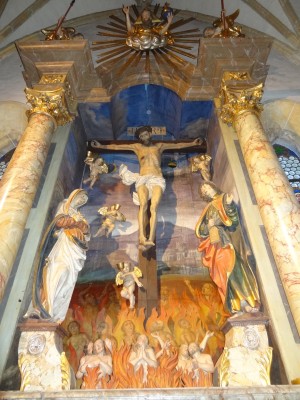 Scripture: Lectionary 638. Memorial of the Exaltation of the Holy Cross. Numbers 21:4-9; Psalm 78:1-2,34-35,36-37,38. Philippians 2:6-11; John 3:13-17:
Scripture: Lectionary 638. Memorial of the Exaltation of the Holy Cross. Numbers 21:4-9; Psalm 78:1-2,34-35,36-37,38. Philippians 2:6-11; John 3:13-17:
“ We adore you, O Christ, and we bless you (praise you), because by your Cross you have redeemed the world.” This is our prayer before the Gospel on this feast of our Lord. We may wonder why the reading from Numbers has been chosen, but after the Gospel for today we realize that Jesus is revealing to Nicodemus—a secret follower of Jesus—that he, Jesus, will be “lifted up” and that those who believe in the Jesus who is exalted on the Cross, they will be redeemed. John will make sure that we the readers and listeners will understand what this double meaning word refers to in his Gospel. He will use the same words in 8:28 and in 12: 32,34. By reading all three of these passages we will know why the fiery serpents in the desert bit the Israelites and those who later looked upon the serpent lifted up on a pole would be healed of the fatal bite. In8:28 we hear the second mention of Jesus’ exaltation on the Cross: “When you lift up the Son of Man, you will come to realize that I AM and that I do nothing by myself. I say only what the Father has taught me.” And in 12:32, 34: “…and I –once I am lifted up from the earth will draw all men to myself.” The crowd objected to his words and queried :How can you claim that the Son of Man must be lifted up?”
Returning to the plight of the Israelites in the desert who complained and sinned and were bitten by the seraph serpents we have this helpful commentary from a Jewish work: “Tradition has it that because the serpent caused Adam and Eve to transgress by means of clever words, the serpent would always be the instrument of punishing people who sin with words (Numbers Rabbah 19:22). Why did Moses’ bronze serpent heal them? According to the Mishnah, it directed the people’s thoughts heavenward as they looked upon it (RH 3:8), just as Moses raised arms directed people’s attention heavenward in their battle with Amalek (Exodus 17:11). The Zohar explains that looking at the bronze serpent reminded the people of why they deserved to be punished, and that is the first step toward repentance and forgiveness (Sh’lah 175). Finally, Hirsch suggests that the image of the serpent reminded people how dangerous the journey through the wilderness was, and how much they depended upon God to guide them through it.” (Etz Hayim, p.889).
St. John Chrysostom, whose feast day was yesterday, says that John’s Gospel is the work of the Evangelist who is the theologian among the four. And in the third century Origen says, “the first fruits of the Gospel is that according to John, whose meaning no one can understand who has not leaned on the breast of Jesus and who has not received Mary from Jesus to be their mother.” This takes us to the finalization and culmination of the exaltation of Jesus on the Cross with Mary and John standing by the cross (John 19:25-27). Here is where she becomes our mother and the mother of Church as she sees her Son lifted upon the cross and returning to the Father.
We see how the double meaning word “lifted up” is the suffering, death, and ultimate triumph of Jesus over death, sin, and evil as he returns to his Father.
We pray with the Marianist Family the Three O’Clock Prayer:
Lord Jesus, we gather in spirit at the foot of the Cross with your Mother and the disciple whom you loved. We ask your pardon for our sins which are the cause of your death. We thank you for remembering us in that hour of salvation and for giving us Mary as our Mother.
St. John, obtain for us the grace of taking Mary into our life, as you did, and of assisting her in her mission. May the Father and the Son and the Holy Spirit be glorified in all places through the Immaculate Virgin Mary. Amen.
Copyright 2013 Fr. Bertrand Buby, S.M.
About the Author

Guest
We welcome guest contributors who graciously volunteer their writing for our readers. Please support our guest writers by visiting their sites, purchasing their work, and leaving comments to thank them for sharing their gifts here on CatholicMom.com. To inquire about serving as a guest contributor, contact editor@CatholicMom.com.


.png?width=1806&height=731&name=CatholicMom_hcfm_logo1_pos_871c_2728c%20(002).png)
Comments